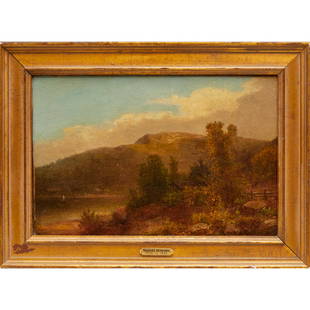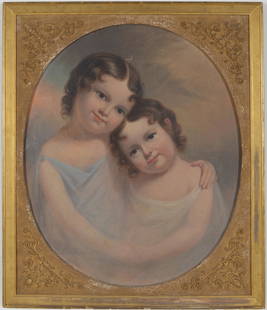
ORIG THOMAS SULLY (1783-1872) GANYMEDE OIL ON CANVAS
Thomas Sully Sale History
View Price Results for Thomas SullyRelated Paintings
More Items from Thomas Sully
View MoreRecommended Art
View More









Item Details
Description
Original Oil on Canvas "Ganymede" Cup Bearer of the Gods, by America's most successful 19th century portrait painter, Thomas Sully. This important oil painting was authenticated by Mantle Fielding, Sully's biographer. One of 5 Cataloged versions that Sully did of Ganymede. Ref: E. Biddle and M. Fielding, The Life and Work of Thomas Sully, Charleston, 1921, Pages 352-353, In magnificent gilt wood frame, in frame measures 22 1/2x26x2 *Provenance: Dr. Douglas D. Ashley Estate, Charleston SC
Thomas Sully was born in 1783 in Horncastle, Lincolnshire, England, the youngest son of nine children born to the actors Matthew and Sarah Chester Sully. At the suggestion of his father's brother-in-law, a theater manager in Virginia and South Carolina, the Sullys emigrated to the United States in 1792. Sully attended school in New York until his mother's death in 1794, when he returned to live with his family in Richmond. From there they moved to Charleston, South Carolina, where the future artist performed on the stage with his parents and siblings.
Following the example of his older brother, the miniature painter Lawrence, Sully resolved to become an artist. He first received art lessons from his young schoolmate Charles Fraser. After an unsuccessful attempt to learn the business of insurance broking, Sully was apprenticed to his brother-in-law, a French emigrée miniaturist named Jean Belzons. After a violent quarrel with his teacher in 1799 Sully left Charleston and joined his brother Lawrence in Richmond. Inspired by the sight of portraits by Henry Benbridge, he continued to study art and opened up his first studio at Richmond in 1804. When Lawrence died in September 1804 Sully assumed responsibility for the family and eventually married his brother's widow Sarah. In 1806 Sully accepted a commission to paint at a theater in New York, where he met William Dunlap, John Wesley Jarvis, and John Trumbull. He invested one hundred dollars to have Trumbull paint a portrait of his wife so that he might learn something of the senior artist's technique. In 1807 he travelled to Boston and spent about three weeks studying with Gilbert Stuart, who encouraged his efforts to become a portraitist.
Later that year Sully moved to Philadelphia, where he remained for the rest of his life. Sully's artistic activity was not confined to Philadelphia, and throughout his long career he made numerous protracted trips to Washington, Baltimore, Boston, New York, and West Point. At the height of his fame in 1837 a Philadelphia association of British expatriates called the Society of the Sons of St. George sent him to England to paint a full-length portrait of the recently crowned Queen Victoria. Sully's professional stature was such that he attracted many pupils, most notable among them Charles Robert Leslie, John Neagle, and Jacob Eichholtz; he also trained several of his children to become competent artists. In 1851 he prepared a short practical guide for portraitists entitled Hints to Young Painters and the Process of Portrait Painting, which was revised in 1871 and published two years later.
Sully was America's foremost exponent of the highly romanticized, painterly, and fluid style of portraiture practiced by the two contemporary British artists he had most admired during his year of study in England, Sir Henry Raeburn and Sir Thomas Lawrence. Although he painted many of the most prominent politicians, clergymen, and military heroes of his era, Sully's fame rests mainly on his exaggeratedly elegant and idealized portraits of fashionable society women, and, to a lesser extent, his sentimental group portraits of children and "fancy pictures." Often painted with a nearly flawless mastery of technique, these ultra-refined images are fundamentally decorative, and the deliberately self-conscious affectations of the sitters create a sense of artificiality that precludes the achievement of any penetrating psychological insight into their characters. This aesthetic, however, appealed greatly to the elite social stratum from which Sully drew his patrons, and earned him the status of being the most successful American portrait painter following the death of Gilbert Stuart in 1828, until his gradual decline in the 1850s. Sully died in Philadelphia in 1872.
Ganymede is a divine hero whose homeland was Troy. Homer describes Ganymede as the most beautiful of mortals. He was the son of Tros of Dardania, from whose name "Troy" was supposed to derive, and of Callirrhoe. His brothers were Ilus and Assaracus. In one version of the myth, he is abducted by Zeus, in the form of an eagle, to serve as cup-bearer in Olympus.
TO BE PROFESSIONALLY SHIPPED.
Weight: 14 pds Measurements: 25x28x5
Condition
loss to paint above one shoulder, crazing, small old repair see back.
Buyer's Premium
- 10%
ORIG THOMAS SULLY (1783-1872) GANYMEDE OIL ON CANVAS
Estimate $30,000 - $40,000
14 bidders are watching this item.
Shipping & Pickup Options
Item located in SHEFFIELD, AL, usSee Policy for Shipping
Payment

TOP
















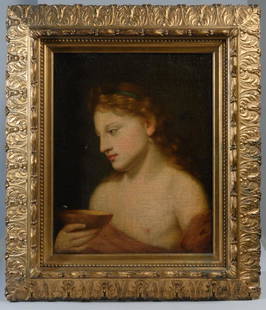


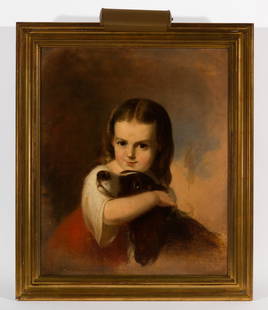

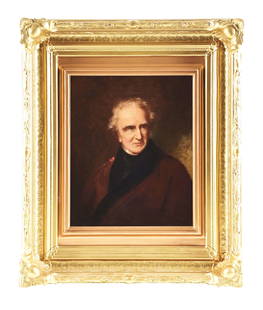


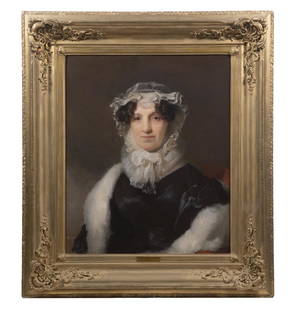








![Style of Thomas Sully, Gilt Framed Oil on Canvas: A gilt framed oil on canvas painting depicting a portrait of a girl, in the style of Thomas Sully. [Canvas approx.: 18" H x 24" W; Frame: 38" H x 32" W]. Provenance: From the Estate of Baroness Gabrie](https://p1.liveauctioneers.com/1221/326908/176009201_1_x.jpg?height=310&quality=70&version=1713556292)

![Thomas WORSEY: Floral Still Life - O/C: Thomas Worsey (British, 1829-1875) a framed oil on canvas depicting a still life with flowers. Signed lower left, "Tho Worsey" and dated, 1873. [Frame, approx.: 36" H x 31" W]. Provenance: From the Es](https://p1.liveauctioneers.com/1221/326908/176009115_1_x.jpg?height=310&quality=70&version=1713556292)







